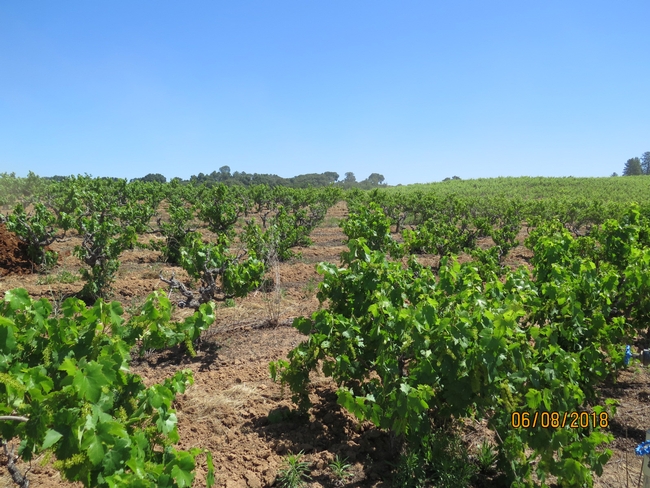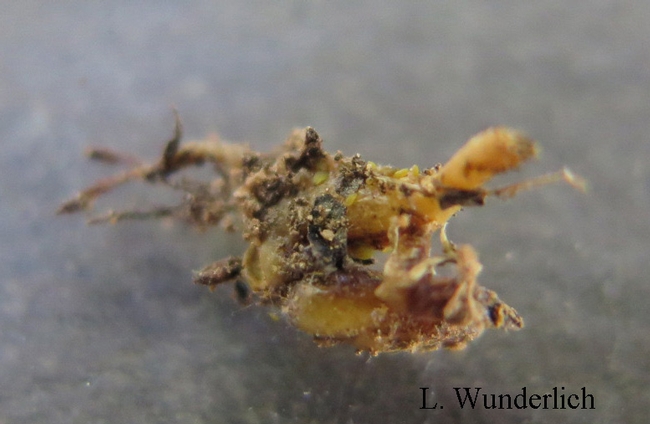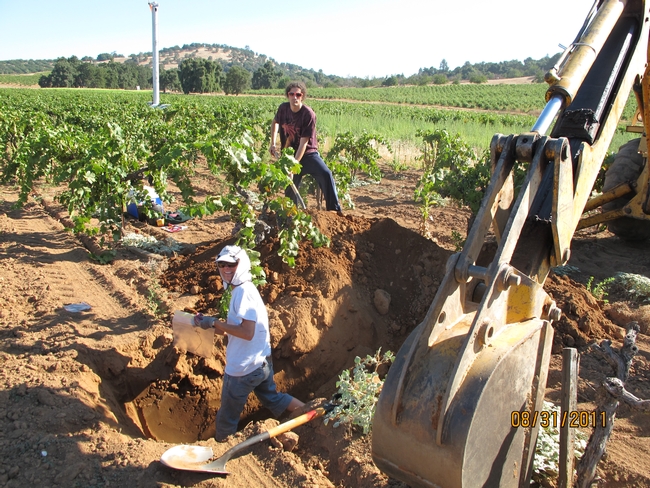
On a farm call recently, I was reminded of a pest I've come to know pretty well since my appointment here in the foothills: Grape Phylloxera (Daktulosphaeria vitifoliae). I'm still surprised when growers are taken aback from the discovery of Phylloxera on their own-rooted vines that are declining ("REALLY? PHYLLOXERA?"). Yes, really. When I first started here as Farm Advisor for viticulture many folks told me that there was NO Phylloxera in the foothills, even though my predecessor, Donna Hirschfelt, knew that phylloxera was here and had spoken about it. And although vines in decline can be due to many different pests (canker, gophers, and Armillaria to name a few), often when I come upon own rooted vines (i.e. those who are not grafted onto rootstock and so have Vitis vinifera as the root) I am able to find phylloxera on the roots.
How can this tiny insect take down these large vines? Phylloxera is an aphid like insect that feeds on the roots 
Phylloxera is native to N. America, so no, we did not get phylloxera from France. Rather, we unwittingly gave it to the Europeans for which they will never forgive us. When feeding, the phylloxera cause swelling of the roots and their feeding damages the root system so that fungi can infect and decay the roots. This is why phylloxera infested vines are so stunted and stressed, after awhile, they have little functional root system left. Thank goodness the plant breeders have come to the rescue to breed hybrids of other Vitis species for our rootstocks, such as V. rupestris (St. George) and V. riparia which are resistant (but NOT immune) to phylloxera. Andy Walker, our very own UC Davis Viticulture breeder, gave an excellent talk on rootstocks and phylloxera a few years ago at my 2013 Foothill Grape Day. His presentation is posted on my webpage with all the other Foothill Grape Day presentations our speakers have granted me the OK to post. A great resource if you ever want to check back for some fun facts!
By the way, there are many ways that phylloxera can spread. Since our rootstock hybrids are not immune, phylloxera can enter a vineyard on the roots of grafted vines. From there, phylloxera nymphs or crawlers will periodically climb their way up to the soil surface, where they can easily be carried by the wind. They can also be picked up on the bottoms of boots and equipment, which is why I always carry a spray bottle of clorox in my truck to spray my boot bottoms off after being in a phylloxera field.
A few years ago, Kent Daane (UC Berkeley Entomology Specialist and biological control whiz) wondered if phylloxera might be spreading around leafroll (this was back before we knew the ID of red blotch). I collaborated with Kent and his then assistant Christina Wistrom in a study where we looked at foothill sites that had both phylloxera AND grapevine leafroll virus. Thankfully, we found no evidence that phylloxera spreads leafroll (but mealybugs, including grape and Gill's mealybug, do).
As own-rooted vines that are many years old are declining, and as the cost of farming these vines continues to increase, we are seeing many older vineyards being replanted in the foothills. This is sad to me, mainly because of the family history in many of these vineyards that are as much as 130 years old! Some winemakers would also argue that these vines produce superior wine, although I think this is in part due to the low yields making fruit highly concentrated (and, for most, growers are paid by the ton, not so much by the age of the vineyard). But phylloxera is a pest that cannot be managed indefinitely, it eventually will win. Some growers choose to apply a systemic insecticide for phylloxera management, but these do not kill the phylloxera eggs. So, we are gradually seeing our historic foothill vineyard landscape change as older, historic own-rooted vineyards are replaced.
Change, though, can sometimes bring unexpected and good things (I often have to remind myself of this). Rootstocks today provide growers a large choice of attributes that can help dial in quality for a given "site capacity". Replanting also gives growers and their winemakers an opportunity to try new varieties that may have a better consumer niche and price for the grower. And, most importantly, the increase in YIELD that comes with phylloxera free vineyards will allow our foothill industry to stay vibrant and alive!
